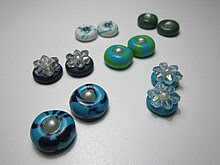Ronnee Strickland - Polymer Clay Artist
Polymer clay is a type of hardenable modeling clay based on the polymerpolyvinyl chloride (PVC). It typically contains no clay minerals, but like mineral clay a liquid is added to dry particles until it achieves gel-like working properties, and similarly, the part is put into an oven to harden, hence its colloquial designation as clay. Polymer clay is generally used for making arts and craft items, and is also used in commercial applications to make decorative parts. Art made from polymer clay can now be found in major museums.
Ronnee Strickland discovered this marvelous substance a long time ago and never tires learning about it.
Polymer clays contain a basis of PVC resin and a liquid plasticizer, making it a plastisol. Polymer clay plastisol is also categorized as a plastigel because of its rheological properties.[5] It is a high yield thixotropic material: when a sufficient force is applied, the material yields, flowing like a viscous liquid until that force is removed, whereupon it returns to being a solid. This plasticity is what makes it useful as modeling clay as opposed to putty or paste. Plastigels retain their shape even when heat is applied, which is why polymer clay does not melt or droop when oven cured.[5] Various gelling agents are added to give it this property, such as aminated bentonite, metallic soaps, or fumed silica.
The base resin can be modified in various ways. Mineral oil, lecithin, and odorless mineral spirits can be added to reduce its viscosity or alter its working properties. Small amounts of zinc oxide, kaolin, or other fillers are sometimes added to increase opacity, elastic modulus, or compression strength. Polymer clay is available in many colors, which can be mixed to create a wide range of colors or gradient blends. Special-effect colors and composites include translucent, fluorescent, phosphorescent, and faux "pearls", "metallics", and "stone."


Comments
Post a Comment